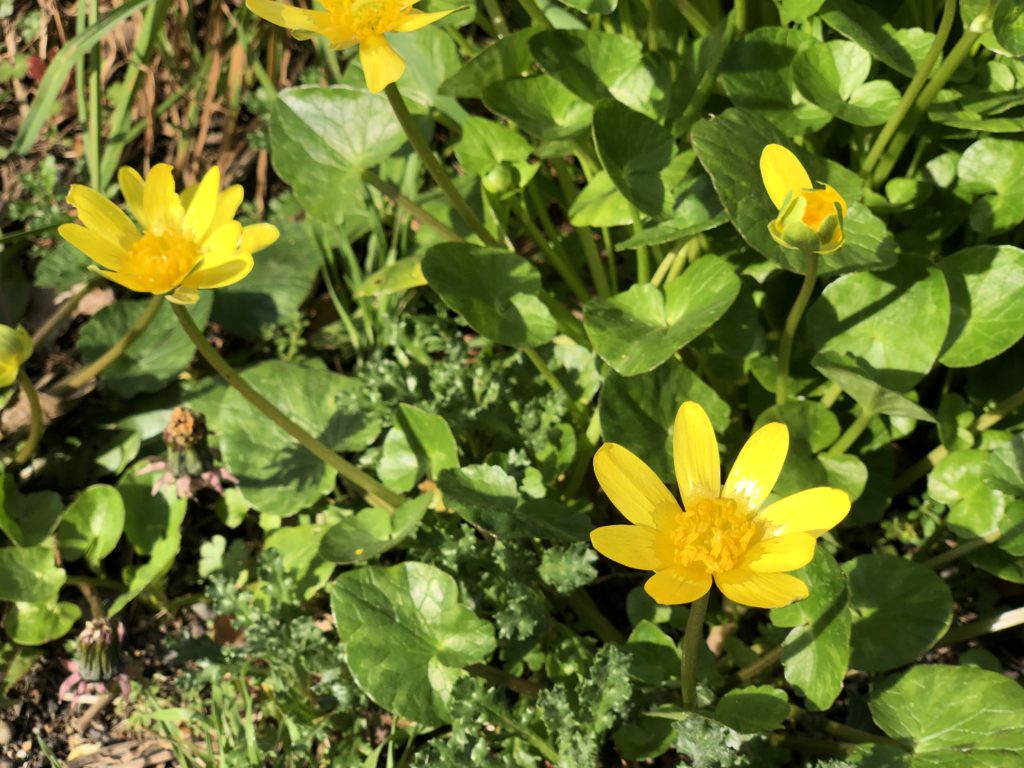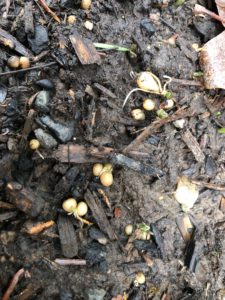Lesser Celandine

STOP THE SPREAD !!!
Lesser Celandine is spreading rapidly in the Arnold Creek watershed. It will take over your yard, your neighbor’s yard, roadside ditches and natural areas. It is very difficult to control once it becomes established. Unless we take action, this very invasive species will crowd out native plants and reduce the diversity of our ecosystem.
*Do not ask for starts and do not share starts.
*Do not wait for it to form a huge mat. Control new plants as soon as they pop up.
*Do not wait until the flowers appear. Check your property in January and February by scanning for the leaves and start controls as early as possible.

CONTROL METHODS
*De-Veg It.
Starting as soon as the leaves first appear, remove all the foliage down to the ground using a hoe, weed eater, or flame weeder. Check often over the growing season and repeat as soon as there is any re-growth.
It will take at least two years for the plant’s tubers to be exhausted.
*Smother It.
Cover with plastic, cardboard, or overlapping newspapers weighed down by chips or compost. Check often and dig or de-veg escapees around the perimeter.
It will take at least two years for the plant’s tubers to be exhausted.
*Dig It.
Bag the plant, the tubers, and all the attached soil and put in the garbage bin. Do not put it in the green compost bin. Check often for re-growth from missed tubers.
Digging is impractical for larger infestations because of the strict disposal requirements and the loss of valuable top soil. Moreover, digging may help propagate the plant because of soil disturbance and the likelihood of not finding all the tubers and bulbils.
FAQs
Q. Why is Lesser Celandine harmful?
A. Lesser Celandine spreads quickly into a dense, monocultural mat. It will take over lawns and spread onto your neighbor’s property. In natural areas it will replace the native understory plants like Trilliums which emerge in the Spring and provide food for pollinators and other benefits to the ecosystem.
Q. How does Lesser Celandine spread?
A. Lesser Celandine can spread via bulbils, tubers, or seeds.
Q. What are bulbils?
A. Shortly before flowering time, miniature plants called bulbils will develop in the leaf axils (the junction of leaf and stem). When the plant dies down the bulbils are left on the ground where they can be picked up and moved around by animals, people, lawn mowers etc. and by water. The following Spring the bulbils will sprout and become new plants. This is probably the main way that Lesser Celandine spreads so widely and covers the ground so quickly.
Q. Why start so early-in January or February-when it is so cold and wet outside?
A. By the time that Lesser Celandine flowers it will have already replenished the nutrients stored in the underground tubers and the above ground bulbils will be forming. Controlling Lesser Celandine early in its life cycle will deplete the tubers and prevent bulbil formation.
Q. What is the difference between Marsh Marigold and Lesser Celandine?
A. Lesser Celandine had three green sepals (petals) under its yellow flower petals and has tuberous roots. Marsh Marigold has neither one of those features. Marsh Marigold is not native to the Northwest but is occasionally planted as an ornamental in gardens. It is not a problem plant and is very seldom seen.
For more information on Lesser Celandine:
https://solvepestproblems.oregonstate.edu/weeds/lesser-celandine

